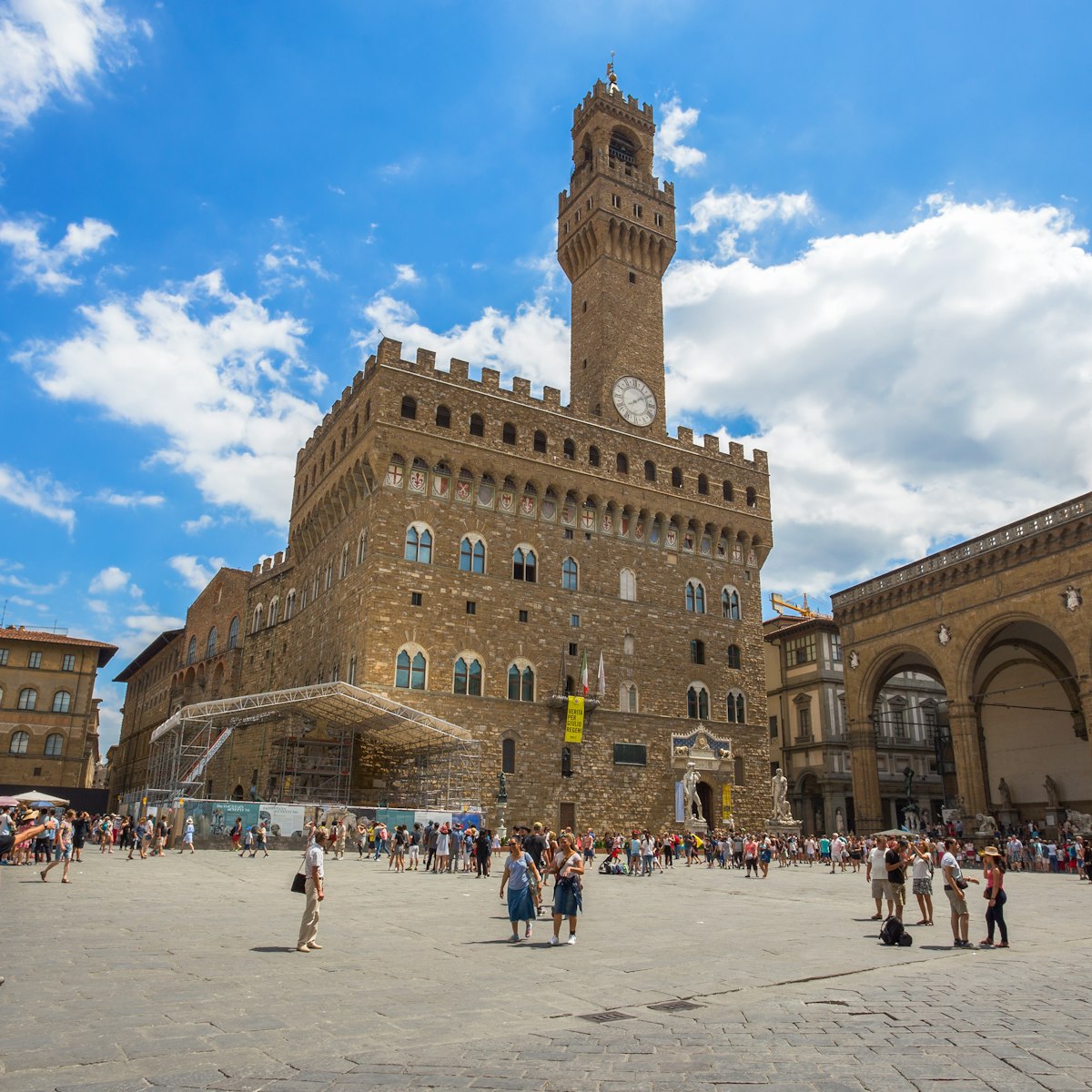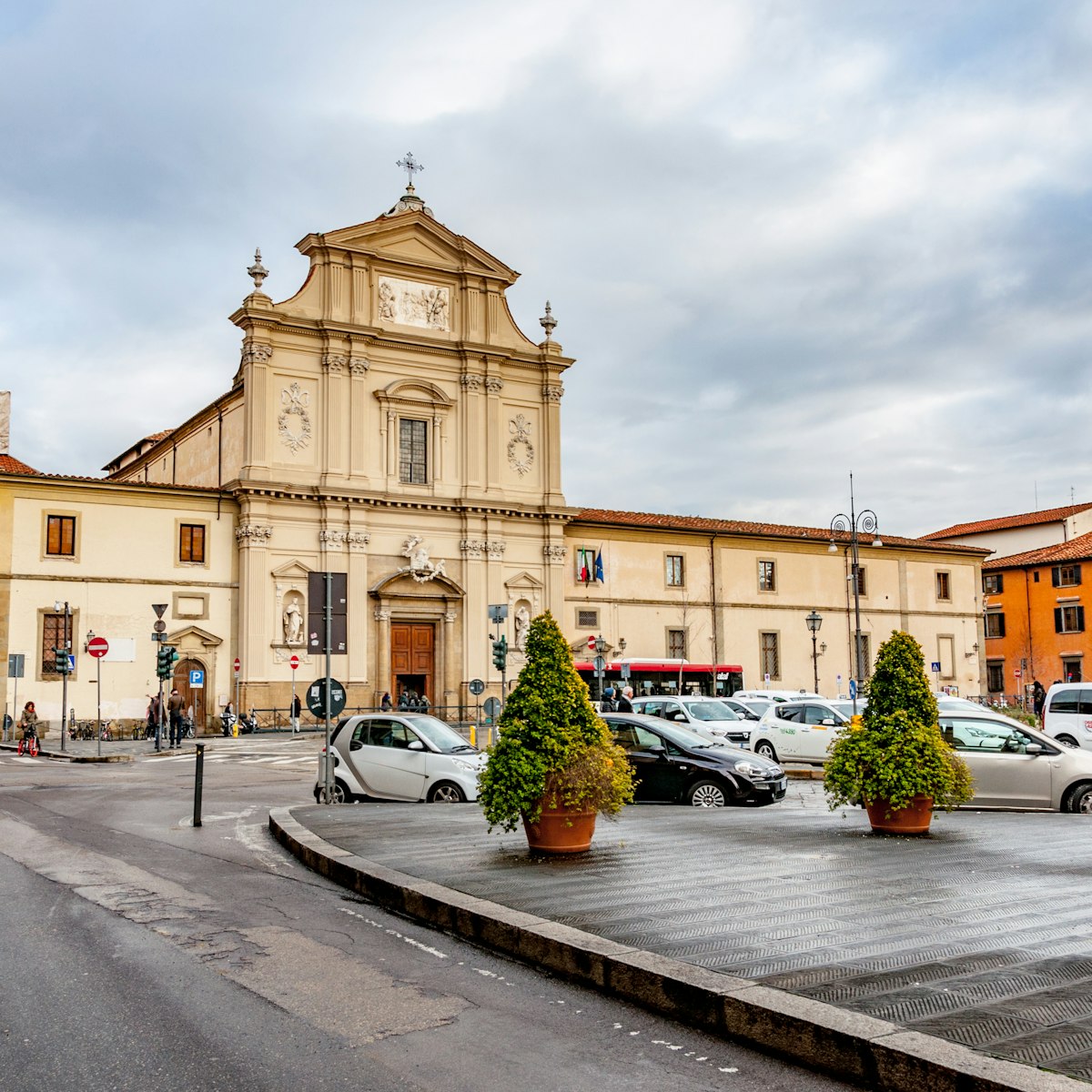The striking green-and-white marble facade of 13th- to 15th-century Basilica di Santa Maria Novella fronts an entire monastical complex, comprising romantic church cloisters and a frescoed chapel. The basilica itself is a treasure chest of artistic masterpieces, climaxing with frescoes by Domenico Ghirlandaio. The lower section of the basilica's striped marbled facade is transitional from Romanesque to Gothic; the upper section and the main doorway (1456–70) were designed by Leon Battista Alberti. Book in advance online to avoid queues.
As you enter, look straight ahead to see Masaccio's superb fresco Trinità (Holy Trinity; 1424–25), one of the first artworks to use the then newly discovered techniques of perspective and proportion. Hanging in the central nave is a luminous painted Crucifix by Giotto (c 1290).
The monumental main altar, Altare Maggiore (1858-61), sits within the Cappella Maggiore, which is decorated with frescoes by Domenico Ghirlandaio. Those on the right depict the life of John the Baptist; those on the left illustrate scenes from the life of the Virgin Mary. The frescoes were painted between 1485 and 1490, and are notable for their depiction of Florentine life during the Renaissance. Spot portraits of Ghirlandaio's contemporaries and members of the Tornabuoni family, who commissioned them.
The first chapel to the right of the altar, Cappella di Filippo Strozzi, features spirited late-15th-century frescoes by Filippino Lippi (son of Fra' Filippo Lippi) depicting the lives of St John the Evangelist and St Philip the Apostle.
To the far left of the altar, up a short flight of stairs in the western transept, is the Cappella Strozzi di Mantova, covered in 14th-century frescoes by Niccolò di Tommaso and Nardo di Cione depicting paradise, purgatory and hell. The altarpiece (1354–57) here was painted by the latter's brother Andrea, better known as Andrea Orcagna.
From the church, walk through a side door into the serene Chiostro Verde (Green Cloister; 1332–62), part of the vast monastical complex occupied by Dominican friars who arrived in Florence in 1219 and settled in Santa Maria Novella two years later. The tranquil cloister takes its name from the green earth base used for the frescoes on three of the cloister's four walls. On its north side is the spectacular Cappellone degli Spagnoli (Spanish Chapel), originally the friars' chapter house and named as such in 1566 when it was given to the Spanish colony in Florence. The chapel is covered in extraordinary frescoes (c 1365–67) by Andrea di Bonaiuto. The vault features depictions of the Resurrection, Ascension and Pentecost, and on the altar wall are scenes of the Via Dolorosa, Crucifixion and Descent into Limbo. On the right wall is a huge fresco of The Militant and Triumphant Church – look in the foreground for a portrait of Cimabue, Giotto, Boccaccio, Petrarch and Dante. Other frescoes in the chapels depict the Triumph of Christian Doctrine, 14 figures symbolising the arts and sciences, and the Life of St Peter.
By the side of the chapel, a passage leads into the Chiostro dei Morti (Cloister of the Dead), an atmospheric vaulted-cloister cemetery existent well before the arrival of the Dominicans to Santa Maria Novella. The tombstones embedded in the walls and floor date from the 13th and 14th centuries, a period when wealthy Florentine families assumed patronage of the series of tiny chapels here.
Head back to the Chiostro Verde and enter the passageway on the western (left) side of the cloister to access the 14th-century Cappella degli Ubriachi and vast Refettorio (Refectory; 1353–54) featuring a 1583 Last Supper by Alessandro Allori. These two rooms form a small museum displaying sacred treasures and ecclesiastical relics from the Santa Maria complex – including brilliantly restored frescoes of the Garden of Eden, originally in the Chiostro Verde, by Paolo Uccello (1397–1475).
Backtrack through the museum to end in the magnificently frescoed Chiostro Grande (Great Cloister; 1340–60), so named because of its majestic size; the crests of the wealthy Florentine families who helped pay for the cloister's sweep of 56 arches are carved on pillars in the loggia. On the cloister's northern side, admire the sweep of cross-vaults in the Dormitorio Settentrionale (Northern Dormitory). A staircase in the cloister's northwest corner leads to the exquisite Cappella del Papa (Papal Chapel; accessible only by guided tour), a chapel built to commemorate a visit by Medici pope Leo X to Florence in 1515. The wall fresco of Saint Veronica by Jacopo Carucci (better known as Pontormo) is one of the finest examples of 16th-century Florentine painting.
There are two entrances to the Santa Maria Novella complex: the main entrance to the basilica or through the tourist office opposite the train station on Piazza della Stazione (which brings you directly into the Chiostro dei Morti).
City-run Mus.e offers fantastic guided tours (€5, 1¼ hours) in English of both the basilica complex in general and Cappella del Papa; reserve in advance online or by phone.








